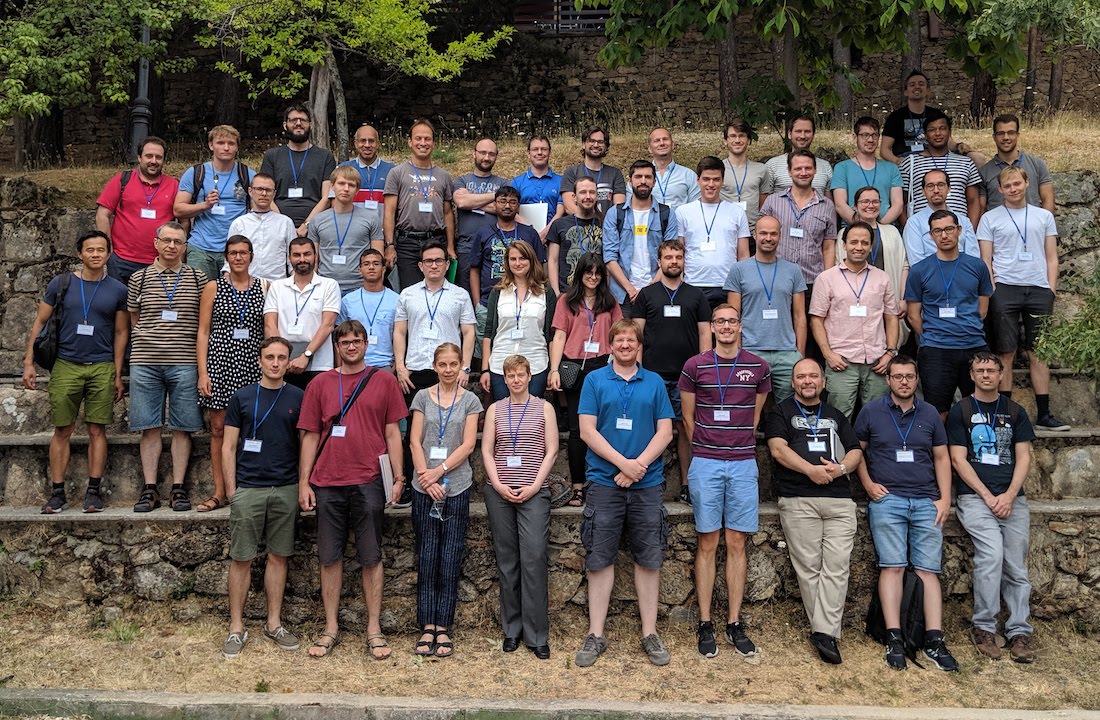MOLECULAR POLARITONICS 2019:
Theoretical and Numerical Approaches
July 8-10, 2019
Miraflores de la Sierra, Madrid
Organizers: Claudiu Genes and
Johannes Feist
Next edition: Molecular Polaritonics 2022
You are viewing the webpage for the 2019 edition of Molecular Polaritonics. For the current edition, please go to Molecular Polaritonics 2022.
Thanks & group photo
Thanks to all the participants for making the first edition of Molecular Polaritonics a success! The (available) PDFs of the talks and posters can be downloaded from the program page. The full-size group photo is available by clicking on the small version below.
Confirmed Invited Speakers
- Stefan Yoshi Buhmann, University of Freiburg, Germany
- Antonio I. Fernández Domínguez, Universidad Autónoma de Madrid, Spain
- Gerrit Groenhof, University of Jyväskylä, Finland
- Felipe Herrera, Universidad de Santiago de Chile, Chile
- Markus Kowalewski, Stockholm University, Sweden
- Mikhail Lemeshko, Institute of Science and Technology Austria, Vienna, Austria
- Michael Ruggenthaler, Max Planck Institute for the Structure and Dynamics of Matter, Hamburg, Germany
- Johannes Schachenmayer, CNRS, Strasbourg, France
- Timur Shegai, Chalmers University of Technology, Gothenburg, Sweden
- Oriol Vendrell, Heidelberg University, Germany
- Joel Yuen-Zhou, University of California San Diego, CA, USA
- Jana Zaumseil, Heidelberg University, Germany
Confirmed Hot Topic Speakers
- Clàudia Climent, Universidad Autónoma de Madrid, Spain
- Peter Kirton, Vienna University of Technology, Austria
- Diego Martín Cano, Max Planck Institute for the Science of Light, Erlangen, Germany
- José Luis Sanz-Vicario, Universidad de Antioquia, Medellin, Colombia
- Christian Sommer, Max Planck Institute for the Science of Light, Erlangen, Germany
Organizers
- Johannes Feist, Universidad Autónoma de Madrid, Spain
- Claudiu Genes, Max Planck Institute for the Science of Light, Erlangen, Germany
Introduction
Traditional nanophotonics is concerned with engineering material systems to control light on a nanometer scale. However, over the last years, it has become clear that the reverse is also possible, i.e., to engineer light modes so as to modify material properties and dynamics. Confining light modes to small volumes (optical or microwave cavities, waveguides, fibers, plasmonic structures, etc.) provides a platform for strong coherent light-matter interactions at the quantum level. Remarkably, this can be achieved even when no actual light is present in the system by engineering the electromagnetic vacuum and its fluctuations, chiefly through the effect of strong coupling, which occurs when the coherent energy exchange between a (confined) light mode and material excitations becomes faster than the decay and decoherence of either constituent. This creates a paradigmatic hybrid quantum system with eigenstates that have mixed light-matter character, so-called polaritons. Organic molecules present a particularly favorable type of emitter to achieve this regime even at room temperature due to their large dipole moments and stability. Polariton formation leads to changes in the excited-state and even ground-state character and energy levels, which can affect a wide range of properties, such as energy transport, photochemical reactions, and even thermally driven ground-state chemical reactions. At the same time, nuclear motion and exciton-phonon coupling strongly affects and determines molecular and material properties from single molecules to the meso- and macroscopic scale, and has been shown to play an important role also in the context of light-matter coupling.
This workshop aims to bring together researchers with expertise in complementary aspects of this highly interdisciplinary field, covering topics such as quantum optics & open quantum systems, quantum chemistry, condensed matter & many-body physics, and macroscopic QED. The goal is to discuss the current state of theoretical approaches and facilitate communication between different fields, as well as to understand fundamental aspects of the important mechanisms at play and to assess and discuss current and possible future applications and technological promises of molecular polaritonics. The workshop will be held in a highly interactive format, with ample time for discussions and informal interactions.
Organizational information
The workshop will be held in the residence “La Cristalera” in Miraflores de la Sierra, a small village in the mountains near Madrid. All participants will stay at the residence, and food will be provided there as well, starting with dinner on Sunday, July 7, until breakfast on Thursday, July 11. For further details and travel information see the venue page.
Registration is now closed (deadline was April 8, 2019).
There is no registration fee, all local costs are covered by the organizers. Travel to and from the venue is not included, however. The workshop is supported by the MMUSCLES ERC grant, the Condensed Matter Physics Center (IFIMAC) at the Universidad Autónoma de Madrid, and the Max Planck Institute for the Science of Light.

 Molecular Polaritonics 2019
Molecular Polaritonics 2019